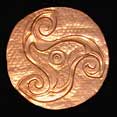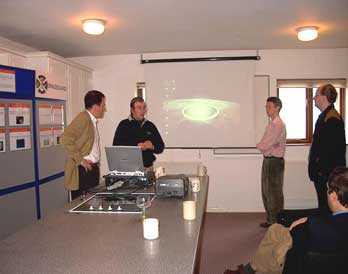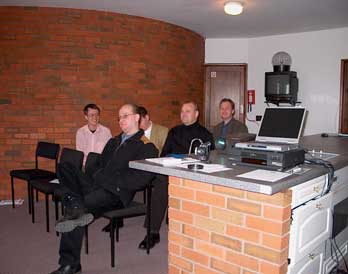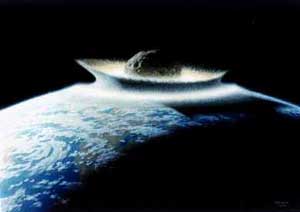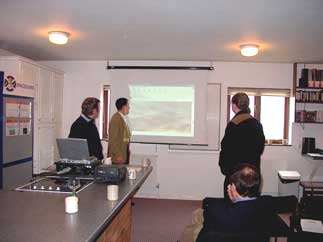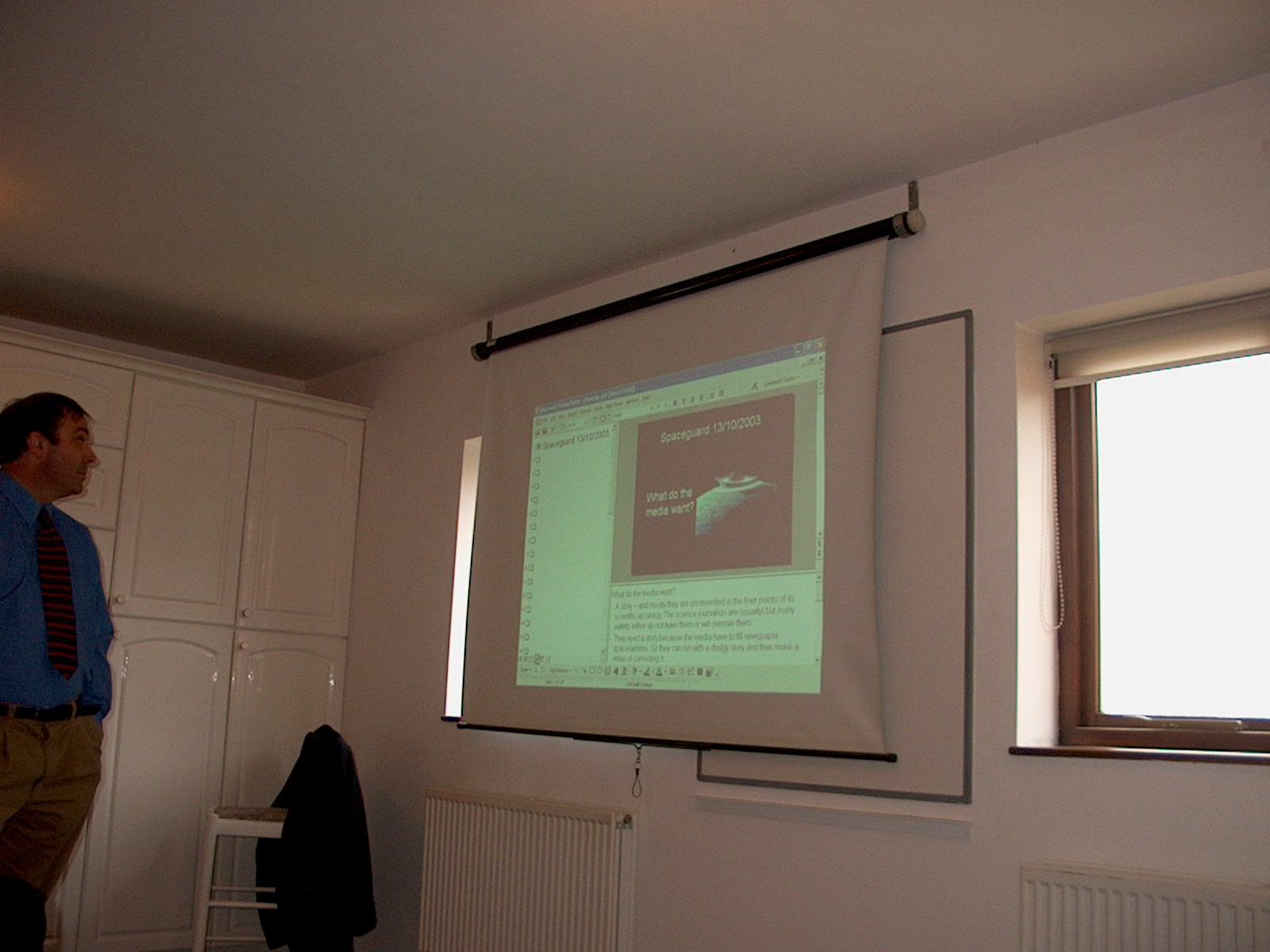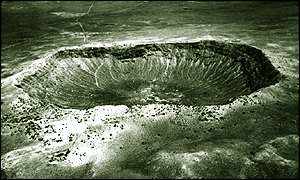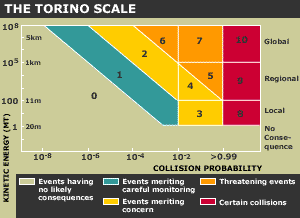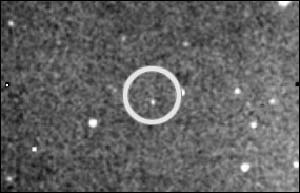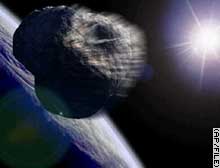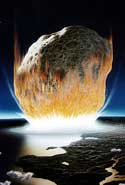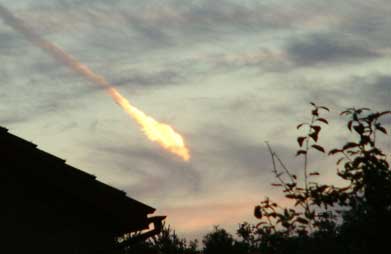Today is Thursday, February 23, 2023
DISCOVERY:……….. a new asteroid is found ……….
REDISCOVERY:…….. an already known asteroid is found again by chance …………
RECOVERY:…………. an asteroid already known is found when deliberately looking for it ……….
PRECOVERY:……….. like a recovery, except back in time looking at images taken years in the past ……….
Dr Asher went on to discuss the “range of uncertainties”, giving examples such as 1:1million for the QQ47 to 1:50 million for an unknown rock coming right at us at short notice. He wound up his presentation by detailing the very real difficulties of trying to explain “Impact Probabilities” to the media in two short sentences – which is about all they’ll actually write in print.
The informal nature of the meeting meant that the presentations were more or less open discussions as various points were raised. CCNet moderator, Dr Benny J. Peiser, offered the suggestion that “if someone from the media phones, perhaps we should ask them to phone back again in 3 months after more observations have been done”.
All agreed that this was an important point, as the need to alert astronomers to look at co-ordinates of initial observations was part of a ‘process’ that Dr Peiser pointed out is really “a non-issue for the general public”. But it was exactly this ‘process’ that had alerted the science journalists who were also recipients of the IAU Circular about the XF11, and it was pointed out that the development and adoption of the Torino Scale had been in response to the media speculation surrounding the XF11. Dr Peiser further pointed out that we don’t want scare stories every year and that “if you have a Torino or Palermo Scale it’s only relevant to astronomers, not to the general public”.
Dr Alan Fitzsimmons, of Queens University, Belfast, expressed similar misgivings, and mentioned several other media scare stories involving NEOs in recent years that, when taken altogether, leaves those involved with NEO research with the feeling that many science journalists don’t fully understand the science they are reporting. Jay Tate felt that there are two media aspects of major concern:
Dr Peiser referred to the scare over the asteroid 2000 BF19 and widespread media reports at the time, some suggesting “that we may need to nuke it”. No-one expressed disagreement with his opinion that the main problem we have is the Internet, and that via the global computer network information about newly discovered NEOs is going out to all sorts of people who are not actually involved in the business of looking for asteroids.
He said, “We have scales, Torino and Palermo, which are for public consumption, and if we are going to retain these scales then all Press Releases should make clear the unlikelihood of impact. We must make clear that a Torino Scale rating of #2 doesn’t warrant any concern.” Dr Asher and Dr Fitzsimmons concurred with this, and it was pointed out that any initial non-zero rating on the Torino Scale seems to stimulate some science journalists to jump the gun and rush stories into print. These stories are then being based on half-calculated orbits that are presented as ‘impact probabilities’ on future dates when the particular object may well be nowhere near our planet. Discussing strategies to prevent this sort of situation becoming standard practice was the main aim of the meeting.
Dr Peiser began his actual presentation with the fact that improved technical capabilities will mean that even more smaller Near Earth Asteroids (NEAs) will be discovered in the coming years, and we will begin to detect the many 10m-sized objects which will, and do, hit our atmosphere. He proposed that there are a number of “uncertain phases between discovery and impact” – between Pre-disaster and Post-disaster, and suggested the following 6-phase definitions:
1 low probability phase 2 moderate probability phase 3 high probability phase 4 very high probability phase 5 confirmation phase 6 mitigation phase He went on to define these as: * Low Probability – below zero on the Palermo Scale
* Moderate Probability – above zero on the Palermo Scale, when it might be sensible to post clarifying information on Internet “risk pages”, but no need for an official Press Release. But he also emphasised that it should be said that the particular object would be observable for the next few months, during which time more certain data would be gathered.
* High Probability – at this phase Dr Peiser gave his opinion that the point to make a statement should be higher than it has been, and that anything Torino-rated 1% is irrelevant for the public.
Jay Tate asked, “At what point does the astronomical community make any comment?”, as mitigation and public announcements are essentially political decisions. Dr David Asher commented that “If there are scares every year then astronomers would soon lose credibility”, something at the very heart of Jay Tate’s motivation in convening the symposium, and the main reason everyone who attended was there.
This important part of the discussion essentially covered Dr Peiser’s ‘Very High Probability Phase’, and he proposed that the ‘Confirmation Phase’ only kicks in when the impact probability reaches 95% to 98%. There was much discussion about these phases, and opinions varied, especially regarding whether or not the ‘Mitigation Phase’ should start somewhere between 10% and 30%. It was generally agreed that the main criteria ruling the start of any ‘Mitigation Phase’ was how much time there would be between discovery and actual impact.
The presentation of the first “Simulation Impact Emergency Crisis” proposed the following scenario:
1. A Tunguska-type impact without much warning. For example, 72 hours warning. What do we do?
2. Odds are it will hit one of our oceans or in sparsely or uninhabited regions of dry land. 3. Discovery is of a 50 – 100 metre object. This led on to discussion about a ‘Pre-Confirmation Phase’, and the main factors suggested were: * What everyone will want to know is whether impact probability goes down to zero, or up to 100% * After 1 -2 days impact probability will increase, but not necessarily all the way to 100% * Size estimates would be based on the intrinsic brightness of the object concerned * We may by now know which hemisphere will be affected, and maybe we can narrow down the impact point because the impact radius will be reduced as more observations of the object are made * A relatively small area of the globe will be affected, and this must be the major aspect of any and all announcements to the public “Simulation Impact Emergency Crisis 2” gave the scenario: a. 180-day warning, with the discovery having, after one week, an impact probability of 1%
b. JPL, NeoDys and similar websites will announce it and the NEO community will then have to react to media enquiries
At this stage it was pointed out that many journalists had not consulted the NEO community before rushing into print with ‘impending impact’ stories over the past few years, and several incidents were referred to. There followed some discussion as to whether or not the NEO community had in the past been too pro-active with the media.
Jay Tate stated that “We cannot tell JPL or whoever, what and/or when to announce impending impacts,” and gave his opinion that the NEO community should be reactive not pro-active to the media. Asteroid 2002 NT7 was mentioned as an example in this context, but Dr Peiser pointed out that the BBC’s Online Science Editor, Dr David Whitehouse, did ring around for confirmation before going into print in this instance. Returning to the presentation, Dr Peiser then introduced a new and disturbing element for consideration:
Weeks 9 to 13 sees the impact probability drop slowly down again, before it goes up in Week 14 to 86%
The discussion of this “Simulation #2” focussed on the likely reaction of the general public to the above scenario. This, of course, would be a general public which, after enduring several years of media-hyped asteroid scares followed closely by stories of the ‘astronomers get it wrong again’ variety a few days later, would likely react in ways that may not be at all predictable.
If the situation were left as it stands at present there would inevitably be major problems for the authorities in maintaining public order, and being able to conduct orderly evacuations of the calculated impact areas. And, importantly, this situation will have arisen because the general public does not understand that the astronomers have NOT ‘got it wrong again’ at all, and that ‘no retractions’ have ever been made by astronomers regarding impending asteroid impacts, despite much media speculation to the contrary.
The general public, it was suggested, will never understand the situation that will have arisen if the NEO community does not make greater efforts to explain ‘the process’ from Discovery to Confirmation – either of impact or not, whichever the case turns out to be.
And it was also suggested that the science journalists themselves may benefit from having ‘the process’ explained to them, as all of the asteroid impact scares from the 1997 XF11 debacle to the most recent QQ47 affair have been started because some journalists have ‘jumped the gun’. As many science correspondents are also in receipt of the IAU Circulars intended for astronomers, and which request further observations to confirm or dismiss earth-crossing orbits likely to lead to impact, some journalists it seems can’t wait for ‘the process’ to complete. Many may simply be unaware of ‘the process’, it was suggested.
While such situations are obviously regrettable, and make the work of those trying to monitor potentially hazardous comets and asteroids even more difficult than it already is, it was heartening for an observer to witness such intense discussions in which the idea of restricting the circulation of information about new discoveries was never even mentioned as an option. The very real problem of how to balance the commitment to openness that characterises the NEO community with the need to avoid repetition of the ‘end of the world’ media hypes of recent years was highlighted by “Simulation #3”. In this scenario a newly discovered PHA was given a theoretical 54 years before impact. a. The impact probability remained below 1% for the first 60 days
b. It never rose above 7% during a 375-day first apparition
c. 600 days later, when the second apparition began, impact probability rose from 4% to 75% over the course of the first 25 days.
Dr Peiser proposed that such a scenario would undoubtedly lead to a period of “prolonged uncertainty” for the public at large. One outcome of this, he proposed, was that we could reasonably expect fundamentalists of various persuasions to exploit the situation, which would likely be interpreted as part of some ‘prophesy’, or another. The resulting implications for public order, panic and general chaos, possibly on a global scale, should not be underestimated in Dr Peiser’s opinion. No-one disagreed with this scenario, though few people in the NEO community worldwide appear to have thought things through in this particular direction.
Jay Tate reiterated a point he had made earlier that “Timescales are important – 500 years or 5 years affects mitigation strategies“. Dr Peiser and others concurred, and he emphasised that even with 5 years warning “Whatever nature throws at us we can mitigate damage by evacuations of impact areas”.
In line with the intended ‘brainstorming’ nature of the meeting, this led to a general discussion about how much of the world’s population is at present familiar with the actual ‘experience’ of evacuation. It was suggested that very few densely populated areas of the world could be expected to react positively at short notice to instructions to evacuate, simply because of unfamiliarity with such emergency procedures. The only obvious exception to this being the eastern seaboard of the United States of America, where typhoon/hurricane warnings are so frequent that the populace take immediate evacuation procedures in their daily stride. Peoples of other lands where annual natural cycles, such as rainfall resulting in regular serious flooding, may also be better mentally prepared to cope with emergency evacuation procedures due to any other forms of disaster.
Following a light lunch, during which time the BBC’s Online Science Editor, Dr David Whitehouse, was brought up to speed with the morning’s discussions, he began his own PowerPoint presentation with the heading:
This certainly struck a chord with the scientists and others involved in the NEO community to whom it was addressed, and Dr Whitehouse emphasised that they should also realise that science journalists and reporters almost always knew much more about the subject than the average editors. It is the editors who will make the decision on whether or not to run a story, and this may often be solely dictated by considerations such as “CNN are running it, so we should too”. Another aspect of media politics that most in the NEO community would not be aware of was that ordinary journalists would keep their ‘exclusive stories’ away from the science correspondents just to get their stories published. They may well have been advised by their editors to run it by the science correspondents, but they know that if their story contains some dodgy science, these science experts will dismiss the story before it gets anywhere near to being printed. So scare stories can often get into print by this route, especially as the media likes “something different” and can always find a “peg” on which to hang the most unlikely of stories.
Dr Whitehouse explained further that “Readers don’t remember the particulars and details of stories. They just remember ‘the impression’ given by the headlines and the first 2 or 3 sentences.” What journalists need when looking at stories about asteroids are simply a date, size, and the odds against impact.
For this the Torino, Palermo, or even a Hollywood scale, is something that is ultimately convenient to both journalist and readership alike. Such scales can be referred to in the body of the text, but also lend themselves perfectly to graphic illustrations that both readers and editors find attractive and helpful. His presentation included numerous examples from a variety of media, including some of his own stories about asteroids that appeared on the BBCi Science/Nature webpages. Example 1 was from the BBC website dated July 24, 2002, and headlined “Space Rock ‘on collision course'”. Dr Whitehouse demonstrated how he as a science editor went about analysing the text, commenting on the soundness or otherwise of the actual ‘science’ in the reporting. He pointed out with each article he used as examples that the statements made, where they are scientifically sound, were often not accurately reflected in the headlines. These, he explained, were generally changed by the editors late on, often just before publication time or date, simply “to drag you into the story”. The reporters themselves often knowing nothing of the headline changes until they actually see their stories in print some time later. Some of the other examples Dr Whitehouse gave included:
Dr Whitehouse described all these stories as “a bit of fun – with graphics”, and reiterated his earlier point that the headlines are usually changed late on by editors. A further example he gave came from both The Times newspaper and The Sun newspaper, which, while they are looked upon as rival publications, used the same graphics probably because they are both from the same Rupert Murdoch stable. The Times text was analysed as containing “good science”, while The Sun even managed to get a comment about the end of the world from that day’s Page Three girl. These particular examples illustrated what happens to sound scientific data once it gets into the public domain. He told those present that people will generally come away with “the impression” they get from the headline, the graphics, and maybe the first 2 or 3 sentences. Many readers may only ever read these, and the fuller explanations given painstakingly by NEO scientists may often not be read at all.
He also emphasised the important point that “The Torino Scale is a God-given gift to journalists looking for a story” as this can often be the “peg” they need to get their stories into print. He explained that, despite the now well-established media cycle of ‘scare-story’ followed shortly by ‘correction’, another story will come along in another 6 months and journalists will always find a new angle to write it from. What the NEO community has to realise when issuing Press Releases is that newspaper and TV news editors have no scientific training or knowledge, and are more concerned with simply “getting the story in”, especially if it’s appearing elsewhere.
But, in contrast to this, Dr Whitehouse explained that even with the best will in the world, “Sometimes you can’t get hold of any experts before your publication deadlines, so you just have to do your best.” He said that most journalists wouldn’t want to repeat the asteroid scare stories too close together, and that anyway these hyped-up stories won’t “queer the pitch” for a real story of a definite threat because the experts will say “this is different”, and the science journalists will listen. This was reassuring – but very much in a ‘lets-wait-and-see’ way.
Having finished his presentation, at this point a general discussion ensued which focussed on the various fears of the NEO community. Fears such as the perception in some quarters that scientific “‘experts’ only use the media to help them get funding for research projects. Further, that many involved with asteroid research feel that the public perception of boffins who have to retract their stories 2 to 3 days later, will make the whole NEO community look bad.
Empathising with these justified concerns, Dr Whitehouse gave his opinion that NEO research is a “young idea”, and because of this many dilemmas are arising for NEO scientists. Many of those present expressed concerns that the NEO community, in their commitment to complete openness with regard to making their discoveries public, might be perceived by the same general public as always ‘crying wolf’. It was explained to him that this is a matter of great concern to all involved with both the asteroid research itself, and with the public outreach efforts of SpaceGuard organisations.
Dr Whitehouse responded, “I personally wouldn’t be bothered about ‘crying wolf’ on these type of stories”. But he also said that we should all be aware of the consequences of putting out Press Releases every month, as if this were to become standard practice the whole of the NEO community certainly would be regarded as trying to manipulate the media. Using the medical world as a comparison, he said, “Some medical specialists go out of their way to generate stories for their own reasons.” The point wasn’t lost on those listening.
Dr Peiser added that, in terms of science, astronomy is always regarded as “a more accurate science”, and astronomers as “a pressure group with a more ethical approach”. Explaining that if we don’t want to be accused of hyping it up, or doing it too much, he asked openly, “how should we handle this problem?”
Dr Whitehouse elaborated his analogy further. “The NEO community talks in terms of ‘risks’,” he said, while Scientists dealing with health matters, i.e. food, BSE, GM issues etc, talk in terms of ‘safety’. Asked by Jay Tate if he thought the NEO community has a PR problem, he replied, “I think your ‘raw material’ is very interesting and very newsworthy. But there are various factions within the scientific community who may or do not see the ‘risks’ in the same way. It is one of the few areas of astronomy that has a general public relevance.” Asked to elaborate, Dr Whitehouse repeated his feelings that “You have wonderful raw material that was not handled in the right way with the media.” This time he used the media coverage of the Beagle Two as analogy. Here was a similar situation, he said, where excellent scientists, with the best of motives but no media savvy, mishandled the media who otherwise might have made much more of the Beagle Two story than they eventually did. On the point of an individual ‘peg’ to hang the story on, Dr David Asher asked about “the general threat out there from asteroids and cometary debris”. Dr Alan Fitzsimmons concurred, and added that, what NEO researchers regard as “the normal general threat”, may not in itself be seen by the media as constituting a ‘peg’ at all. He explained that “the normal general threat” posed to the Earth by NEOs on a daily basis is in fact “the context” in which all the detection programmes have to operate. Indeed, it is “the context” in which the Earth itself exists. And this is where the main dilemma for the NEO community seems to lie in its dealings with the media. Although no-one mentioned it specifically during the meeting, the general public would probably be amazed to learn that, although estimates vary, the Earth sweeps up somewhere close to 145,000 tonnes of cosmic dust and cometary debris each year in its orbit around the sun. In all probability most science journalists would be amazed to learn this fact as well, so in a way it’s not surprising that some incoming space rock appears ‘out-of-the-ordinary’ even to most of them. But this is “the context” in which NEO scientists have to search the skies for ‘rogue asteroids’ on Earth-crossing orbits. And it was this point that was emerging in the discussions as being central to the general misunderstandings that have characterised media coverage of the asteroid threat in the past few years. Dr Peiser, who is the moderator of the CCNet, reflected this reality when he said, “We get 5 to 10 asteroid stories a month. We should learn lessons from these mishaps in the media. The impression people are left with is one where the NEO community is seen as having to retract stories, even though no-one has ‘retracted’ anything.” He carried on to explain in more detail that “The process of discovering true orbits is not at all known by the general public.”
Dr Whitehouse advised that future dealings with the media would have to be better thought out in advance, especially in terms of the issuing of Press Releases. “You’ve got to talk to journalists about other aspects and ways of looking at asteroids than impact probabilities,” he said, and suggested that, “the NEO community needs to become more media savvy, and look for stories other than ones about the latest rock to be discovered.”
There was much animated discussion about this, and Dr Peiser summed up the present situation, saying, “We risk being perceived as being too hasty, and some science correspondents will be reluctant to look at similar stories again.” While this opinion was realistic in the context of past experience, it was, though, rather pessimistic. There are many other reasons why media professionals may not always appear interested in asteroid stories, explained Dr Whitehouse, “Science journalists don’t want to be seen as ‘over-selling’ their stories. And some editors don’t like science stories at all.”
“The picture the public are getting is one where they realise there is an active and developing science looking at the threat from NEOs. With BBC News Online we try to write stories in such a way that the readers will get the gist of the story in the first four paragraphs,” he said. Going on to reassure the scientists that their handling of the media will improve as they, in turn, begin to understand just how the media works, he explained that there are “A great number of scientists who don’t appreciate the complexities of the media. Different types of stories for different outlets.”
Jay Tate, whose job it now is to present the case made by NEO scientists to both the media and the public at large, brought up the point that the NEO community is sometimes looked upon sceptically by other astronomers. He asked generally, now that the new Torino Scale ratings will show Torino #1 as ‘normal’, “How can we manage it?” To this Dr Peiser added, “The Torino Scale is not helpful because it doesn’t put the risk in context,” explaining that, for any newly discovered NEO, “the ‘impact probability’ is meaningless unless we explain how long it has been observed” . Dr Whitehouse agreed, and advised “You have to find a way of explaining that Torino Scale classification is a ‘temporary factor’.”
While Dr Whitehouse may be one of the few science journalists who really does understand the problems facing the NEO community, regarding the dilemma of explaining ‘the context’ referred to by the scientists he cautioned, “If you say this is ‘commonplace’ you take away the root of the story. You have to find a way to say Torino 1 to 3 is of technical interest only, and of no human concern.” To which Dr Peiser added, “The ‘impact probability’ is meaningless unless we explain how long it’s been observed.”
In that instance there had indeed been ‘a retraction’, and how the subsequent furore may affect the credibility of the NEO community in the future was something some participants were left pondering as the meeting came to a close.
John Michael, The Morien Institute, October 14th 2003
It is open for Public Tours (suitable for ages 9+), and also for
1996-2020
|
